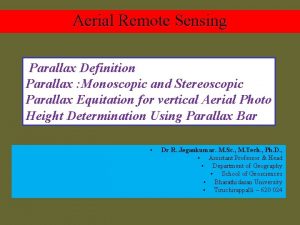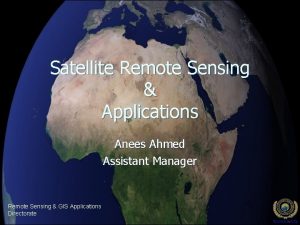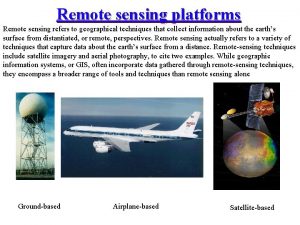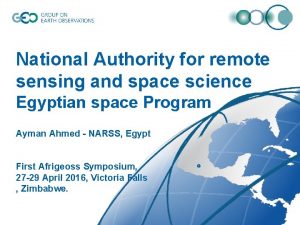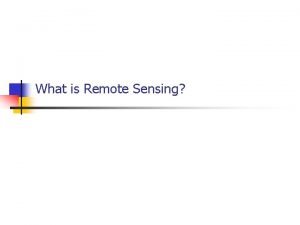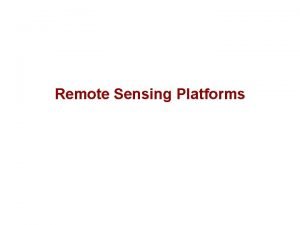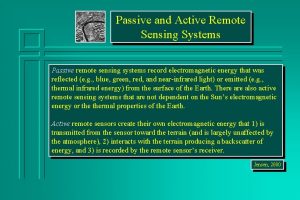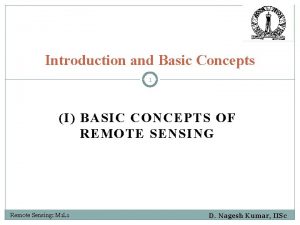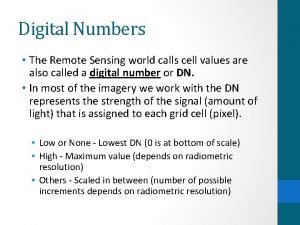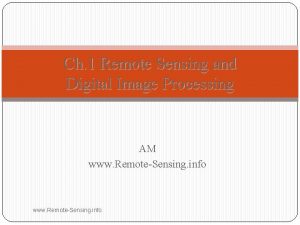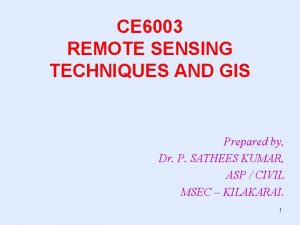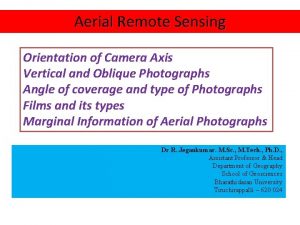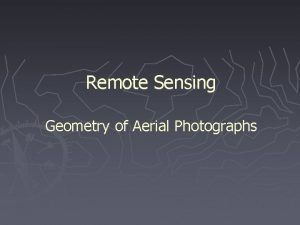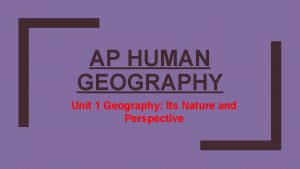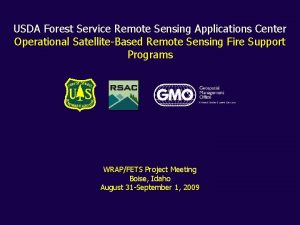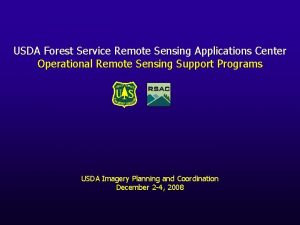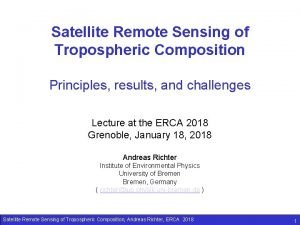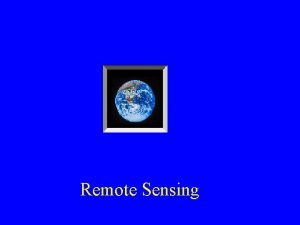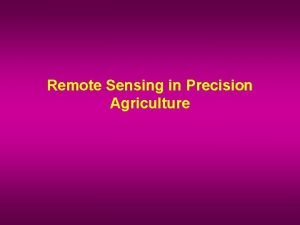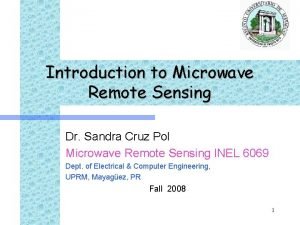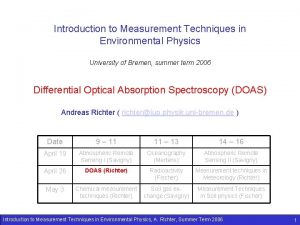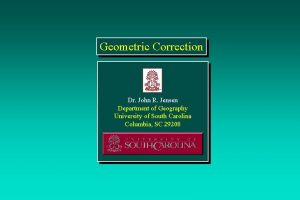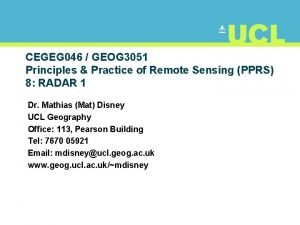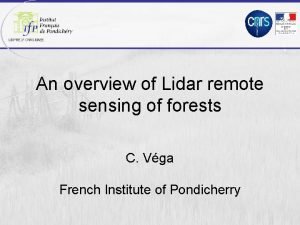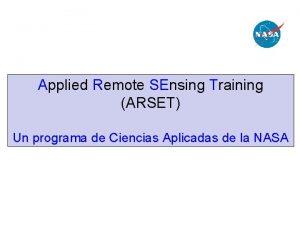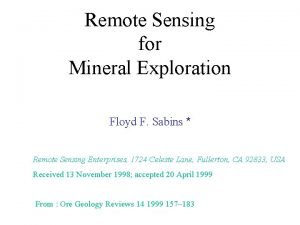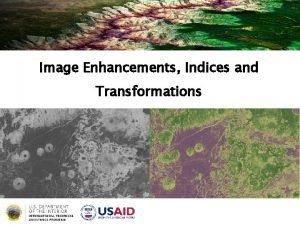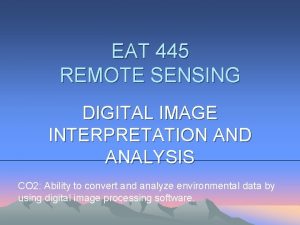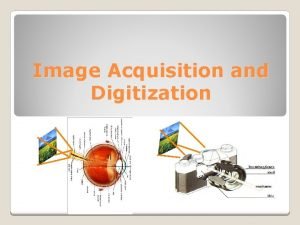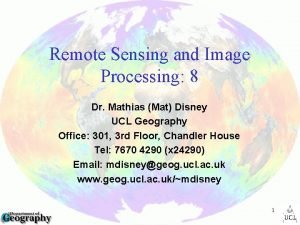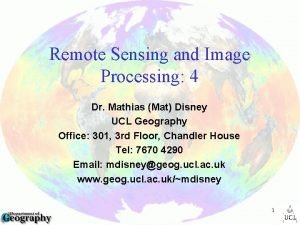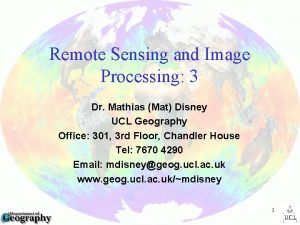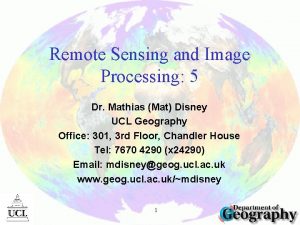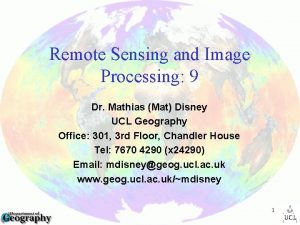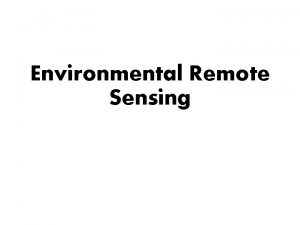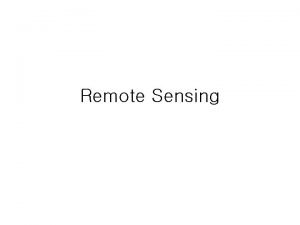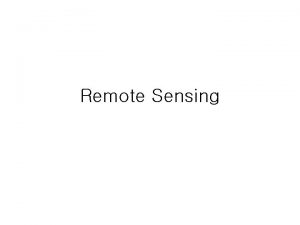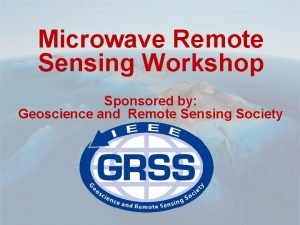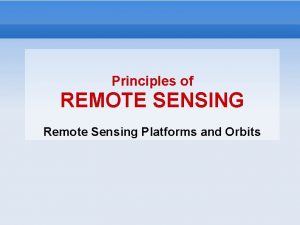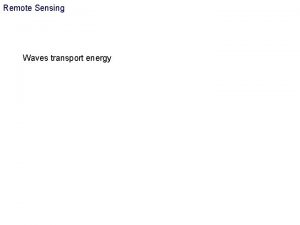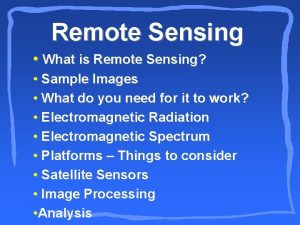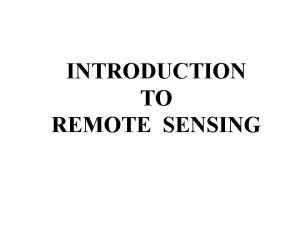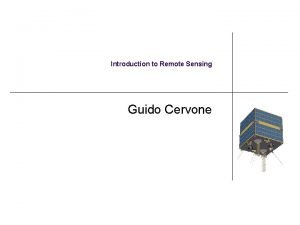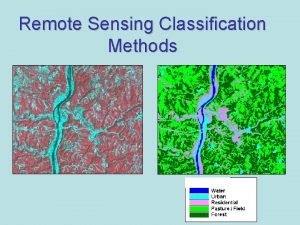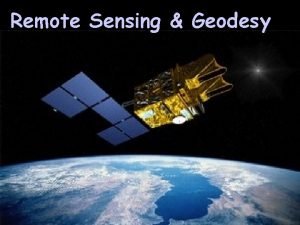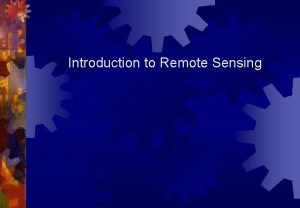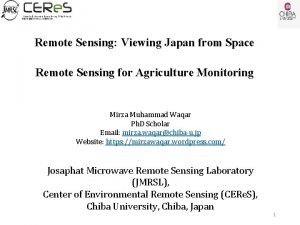Remote Sensing and Image Processing 2 Dr Mathias






































- Slides: 38

Remote Sensing and Image Processing: 2 Dr. Mathias (Mat) Disney UCL Geography Office: 301, 3 rd Floor, Chandler House Tel: 7670 4290 Email: mdisney@geog. ucl. ac. uk www. geog. ucl. ac. uk/~mdisney 1

Image processing: image display and enhancement Purpose • visual enhancement to aid interpretation • enhancement for improvement of information extraction techniques • Today we will look at image display and histogram manipulation (contrast ehancement etc. ) 2

Image Display • The quality of image display depends on the quality of the display device used – and the way it is set up / used … • computer screen - RGB colour guns – e. g. 24 bit screen (16777216) • 8 bits/colour (28) • or address differently 3

Colour Composites ‘Real Colour’ composite red band on red green band on green blue band on blue Swanley, Landsat TM 1988 4

Colour Composites ‘Real Colour’ composite red band on red 5

Colour Composites ‘Real Colour’ composite red band on red green band on green 6

Colour Composites ‘Real Colour’ composite red band on red green band on green blue band on blue approximation to ‘real colour’. . . 7

Colour Composites ‘False Colour’ composite NIR band on red band on green band on blue 8

Colour Composites ‘False Colour’ composite NIR band on red band on green band on blue 9

Colour Composites ‘False Colour’ composite • many channel data, much not comparable to RGB (visible) – e. g. Multi-temporal data – AVHRR MVC 1995 April August September 10

Greyscale Display Put same information on R, G, B: August 1995 11

Density Slicing 12

Density Slicing 13

Density Slicing Don’t always want to use full dynamic range of display Density slicing: • a crude form of classification 14

Density Slicing Or use single cutoff = Thresholding 15

Density Slicing Or use single cutoff with grey level after that point ‘Semi-Thresholding’ 16

Pseudocolour • use colour to enhance features in a single band – each DN assigned a different 'colour' in the image display 17

Pseudocolour • Or combine with density slicing / thresholding 18

Histogram Manipluation • WHAT IS A HISTOGRAM? 19

Histogram Manipluation • WHAT IS A HISTOGRAM? 20

Histogram Manipluation • WHAT IS A HISTOGRAM? Frequency of occurrence (of specific DN) 21

Histogram Manipluation • Analysis of histogram – information on the dynamic range and distribution of DN • attempts at visual enhancement • also useful for analysis, e. g. when a multimodal distibution is observed 22

Histogram Manipluation • Analysis of histogram – information on the dynamic range and distribution of DN • attempts at visual enhancement • also useful for analysis, e. g. when a multimodal distibution is observed 23

Histogram Manipluation Typical histogram manipulation algorithms: 0 output 255 Linear Transformation 0 255 input 24

Histogram Manipluation Typical histogram manipulation algorithms: 0 output 255 Linear Transformation 0 255 input 25

Histogram Manipluation Typical histogram manipulation algorithms: Linear Transformation • Can automatically scale between upper and lower limits • or apply manual limits • or apply piecewise operator But automatic not always useful. . . 26

Histogram Manipluation Typical histogram manipulation algorithms: Histogram Equalisation Attempt is made to ‘equalise’ the frequency distribution across the full DN range 27

Histogram Manipluation Typical histogram manipulation algorithms: Histogram Equalisation Attempt to split the histogram into ‘equal areas’ 28

Histogram Manipluation Typical histogram manipulation algorithms: Histogram Equalisation Resultant histogram uses DN range in proportion to frequency of occurrence 29

Histogram Manipluation Typical histogram manipulation algorithms: Histogram Equalisation • Useful ‘automatic’ operation, attempting to produce ‘flat’ histogram • Doesn’t suffer from ‘tail’ problems of linear transformation • Like all these transforms, not always successful • Histogram Normalisation is similar idea • Attempts to produce ‘normal’ distribution in output histogram • both useful when a distribution is very skewed or multimodal skewed 30

Colour Spaces • Define ‘colour space’ in terms of RGB • Only for visible part of spectrum: 31

Colour Spaces • RGB axes: 32

Colour Spaces • RGB (primaries) as axes 33

Colour Spaces • Alternative: CMYK ‘subtractive primaries’ • often used for printing (& some TV) 34

Colour Spaces • Alternative: CMYK ‘subtractive primaries’ 35

Colour Spaces • Other important concept: HSI transforms • Hue (which shade of color) • Saturation (how much color) • Intensity • also, HSV (value), HSL (lightness) 36

Colour Spaces • Other important concept: HSI transforms 37

Practical 1 • Histogram manipulation – Contrast stretching and histogram equalisation • visual (qualitative) enhancement of images according to brightness • Highlight clouds / sea / land in AVHRR image of UK • Multispectral information – Different DN (digital number) values in different bands – Due to different properties of surfaces 38
 Stereoscopic parallax
Stereoscopic parallax Remote sensing image
Remote sensing image Ifov and fov in remote sensing
Ifov and fov in remote sensing National authority for remote sensing and space sciences
National authority for remote sensing and space sciences N-rays
N-rays Remote sensing platforms
Remote sensing platforms Passive remote sensing
Passive remote sensing Limitations of remote sensing
Limitations of remote sensing Digital number remote sensing
Digital number remote sensing Limitations of remote sensing
Limitations of remote sensing Idealized remote sensing system
Idealized remote sensing system Geospatial data definition ap human geography
Geospatial data definition ap human geography Remote sensing
Remote sensing Strip camera in remote sensing
Strip camera in remote sensing Geometry of aerial photographs
Geometry of aerial photographs Canada centre for remote sensing
Canada centre for remote sensing Remote sensing ap human geography
Remote sensing ap human geography Remote sensing applications center
Remote sensing applications center Remote sensing applications center
Remote sensing applications center Remote sensing physics
Remote sensing physics Microwave remote sensing lecture notes
Microwave remote sensing lecture notes Remote sensing in precision agriculture
Remote sensing in precision agriculture Aerial photography in remote sensing pdf
Aerial photography in remote sensing pdf Introduction to microwave remote sensing
Introduction to microwave remote sensing Remote sensing physics
Remote sensing physics Geometric errors in remote sensing
Geometric errors in remote sensing Cegeg
Cegeg Full waveform lidar
Full waveform lidar Remote sensing
Remote sensing Applied remote sensing training program
Applied remote sensing training program Advantages of remote sensing
Advantages of remote sensing Remote sensing
Remote sensing Digital interpretation in remote sensing
Digital interpretation in remote sensing Image sensing and acquisition
Image sensing and acquisition Unsharp masking matlab
Unsharp masking matlab Fractal image
Fractal image Histogram processing in digital image processing
Histogram processing in digital image processing Neighborhood processing in digital image processing
Neighborhood processing in digital image processing What is point processing in digital image processing
What is point processing in digital image processing
